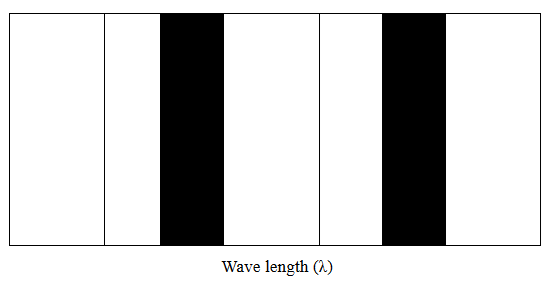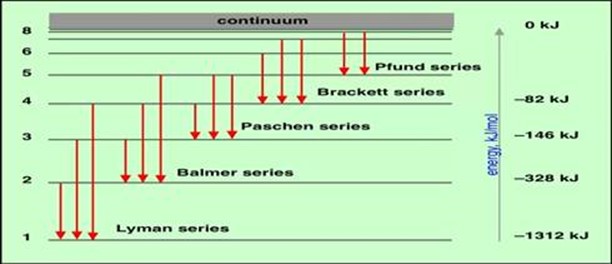ATOMIC SPECTRUM
Definition: Are light waves which have definite line and colour because they have intermediate wave length which cannot be detected by a human eye. These spectrums have no harmful affect on human. Atomic spectrum produced once the atom gain energy which cause the electron to be excited and jump from lowest energy level. This results into an atom being unstable in order to maintain the stability these electrons return back to its group state which accompanied with release of energy inform of radiation. These radiation have wavelength which detected by a human eye of definite colour definite wave and definite line.
Continuous Spectrum: are spectrums which contain all possible frequency over wide range of energy. Continuous spectrums are colourless and have no definite line because they contain very short wave lengths which are not detected by an eye. The continuous spectrum recorded in a spectrographic plate as given below.

Line spectrum: is a spectrum which consists of scattered definite line. These spectrums have very long wave length. The spectrographic plate of line spectrum 
Band Spectrum: Band spectrum are spectrums which consists of a group of definite line in small bands. The spectrographic plate of band spectrum includes the following: 
BOHR-ATOMIC THEORY
(i) H – SPECTRUM
Definition:
Is a definite line and colour which resulted when electric discharge is passed through hydrogen gas in the emission tube under very low pressure. The H – spectrum recorded in the spectrographic plate. The following is a horizontal diagram of H-spectrum
| UV | Violet | Infrared Red |
Red | |||||
| X – ray | Radio electron | |||||||
| – ray | Television wave |
|||||||
| UV – ray | ||||||||
| Invisible | ||||||||
edu.uptymez.com
Note: wave length increases
The explanation of horizontal diagram in terms of atomic structure:-
First band: is a colourless band or invisible band. These are spectrum produced by electrons which excited from the first shell. The electron from the first shell experience stronger nuclear attractive force which use high energy in order to jump toward highest energy level. When these electron returned back release high amount of energy which have shorter wave length. These wave lengths are not detected by a human eye. The radiations formed are continuous spectrum such as X – ray, sun rays etc.
Second band: is a visible band which has definite line and colour. These are line spectrum, produced by electron which excited from the second shell. The electron in the second shell need moderate energy in order to jump towards highest energy level when returned back release a normal energy which its wave length detected by a human eye.
Third band: Is invisible band. These spectrums are colourless and have no definite line.The electrons which produce these spectrum caused the scattered spectrum which appear as a colourless band. This is due to the lowest energy and highest wave length. The following include vertical diagram of H-spectrum.
The vertical diagram of Hydrogen Spectrum

Lyman series: is a series of spectrum which resulted by electron excited from the first shell (n =1). These series correspond to the invisible band or colourless band.
Balmer series: is a series of spectrum which resulted by the electron which excited from the second shell (n = 2) this corresponds with visible or violet band.
Paschen’s series: is a series of spectrum which resulted with electron excited from the third shell (n = 3) etc.
Bracket series: is a series of spectrum which resulted with electron which excited from the forth shell (n = 4) etc.
p-fund series: is a series of spectrum which resulted with the electron which exited from the fifth shell (n=5).
PLANCK’S QUANTUM THEORY
Planck put forward the Planck’s quantum theory. This theory has three main points which include the following;-
i. Any radiation should be association with energy.
ii. The energy is released inform of radiation, occur in small packets called quanta.
iii.The energy is directly proportion to the frequency.
E  f
f
E = hf……………………..(1)
Since h = Planck’s constant
h = 6.63 x 10 -34 JS
n= 1
Since f = 
E =  ………………….(2)
………………….(2)
C = 3.0 x 108 ms-1
REYDBERG EQUATION
Reydberg put forward a principle which applied to find wave length of spectrum. The wave length of H-spectrum determined is applied to find frequency and energy of the H- spectrum. The wave number is inversely proportional to the square of energy level differences ( n2).
n2).
V 

1/V = RH  n2
n2
V =  RH
RH
Since V = 1/λ
 =
= 
 ………………. (3)
………………. (3)
Where λ= wave length
n1 = lowest energy level
n2 = highest energy level
RH = Reydberg constant RH is 1.09 x 107m-1
The value of n1 and n2 for H-spectrum can be obtained if given number of line and number of series. The value n1 is equal number of series given. But the value n2 is equal to the number of line plus the number of series. Example the value of n1 and n2 of third line of Balmer’s series include the following:-
Number of line = Third line
Number of series = Balmer’s series
n1 = number of series = 2
n2 = number of line + Number of series
= 3 + 2
n = 5
But: 
= 1.09 X 107m-1[1/22-1/52]
= 1.09 X 107m-1[1/4-1/25]
= 1.09 X 107m-1[(25-4)/100]
= 1.09 X 107m-1[(21/100]
 λ = 4.45 x 10-7m of third line
λ = 4.45 x 10-7m of third line
E= 
E=6.3 x 10-3 Js x 3.0 x 108ms-1
4.45 x 10-7m
E=4.25 x 10-19J
Also;
f = 
f = 
f = 6.74 x 1014s-1
f = 6.74 x 1014Hz
TRANSITION ENERGY
Is the energy which is required to shift electron from one shell to another. The energy required to shift electrons from one shell to another should be equal to the energy difference between those two shells. The energy difference between lowest energy level E1 and highest energy level E2 is obtained by using the following expression;-
E = E2 – E1……………… (1)
The trend of transition of electrons include the following;
E = E2 – E1 – Transition take place from E1 – E2 exactly.
E > E2 – E1 – Transition take place from E1 toward above E2
E < E2 – E1 – Transition take place from E1 and hang between E1 and E2
But if electrons gain enough energy which is equal to the ionization energy result the electron to jump completely from ground state to infinite. These electrons cannot return back instead leave atom ionized positively. The energy supplied to the atom results to be excited and electron move completely from the ground state to the infinite. The energy supplied to the electrons is used as ionization energy and as kinetic energy. The ionization energy of electrons is equal to the amount of energy associated by electron in the shell or quantum number where it belongs.
The following expression is used to find the energy associated by electrons or energy of that shell.
1/λ = RH
Let n1 = n
n2 = ∞

 since 1/
since 1/ = 0
= 0
1/λ =  ………………………..(i)
………………………..(i)
E = hc/λ
E/hc = 1/λ ……………………..(ii)
Substitute (ii) into (i)
 =
= 
E = 
E = 
Since R, h and C are constant
1eV = 1.6 x 10-19J
1MeV = 106eV
1MeV = 1.6 x 10-13J
But discovered that the energy increase from the nucleus atom toward the high energy level. The energy increases from first shell toward seventh shell. From seventh shell the energy is zero or the energy at infinite is zero. Then the energy from infinite which is zero towards the lowest shell decreases and results to be negative value of energy
n∞ = 0.00ev
n7 = -0.15ev
n6 = -0.21ev
n5 = -0.54ev
n4 = -0.84ev
n3 = -1.50ev
n2 = -3.40ev
n1 = -13.60ev
E = E2 – E1
= E – En
= 0 – En
= 0 – 
E = 
The negative value occurs because the energy of infinite is zero. Since energy increase from nuclear towards highest energy level result the energy of each shell be negative value. This formula is used to determine energy of electron at each shell.
Example
i. Find the first ionization energy of potassium.
ii. Find the wavelength, frequency and energy of third line of Balmer’s series ( RH = 1.09 x 107m-1)
iii.If the wavelength of the first number of Balmer’s series is 6563Å. Calculate Reydberg constant and wavelength of the first member of the Lyman series.
iv.Find energy associated with electrons in the quantum number 2.
Solution:
i. E = I.E
k = 2:8:8:1
E = 
E = 
= -1.36 x 10-19J
E = E2 – E1
E = 0 – -1.36 x 10-19 J
 E = 1.39 x 10-19J
E = 1.39 x 10-19J
ii. n1 = 2
n2 = 3 + 1





λ = 
 λ= 4.86 x 10-7m
λ= 4.86 x 10-7m
iii. λ = 6563A
From 




RH = 
RH = 1.09 x 10-3 A-1
RH = 1.9 x 10 -3 x 1010m-1
RH = 1.09 x 107m-1
iv. E =?
n = 2
E = 
E =  J
J
E= -5.44 x 10-19J
Example
The U.V light has a wave length 2950 Å. Calculate its frequency energy 1A = 10-10M
= 10-10M
Given  J
J
 J
J
If the electron dropped from E4 to E2: Find the frequency and wave length energy release
Given line spectrum

Wave length
i. Which line has highest frequency and energy?
ii. Which line has lowest frequency and energy?
iii. Find the energy and frequency of each line in (i) and (ii) above?
State either or not the transition of electrons would occur if energy supplied is
i. Greater than E4 – E2
ii. Equal to E4 – E2
iii. Less than E4 – E2
iv. Greater than E3 – E2 but less than E4 – E2
v. Smaller than E4 – E2
Solution:
a)  = 2950A
= 2950A
f = c
λ
f = 
f = 1.02×10-2 S-1
E= hf
E = 6.3 x 10-34Js x 1.02 x 10-2 S-1
E = 6.426 x 10-36J
b) E4 = -1.36 x 10-19J
E2 = -15.44 x 10-19J
E = E2 – E1
E = E4 – E2
E = (-1.36 x 10-19) – (-5.44 x 10-19)
E = 4.08 x 10-1
But:
E = hf
f = 
f = 
f = 6.15 x 1014 S-1
Hence:
F =
λ = 
λ = 
λ = 4.88 x 10-7m
C. i) A line of wave length 2030A
ii) A line of wave length 8092 A
iii) f =?
E =?
Line of 2030A
Since f =
f = 
f = 1.48 x 1015S-1
E = hf
E = 6.3 x 10-34Js x 1.48 x 1015
 E=9.32 X 10-19 J
E=9.32 X 10-19 J
D) Solution
i) Greater than E4 – E2 result transition of electron from E1 and above E4
ii) Equal E4 – E2 transition take place from E2 to E4
iii) Smaller than E4 – E2 result transition of electrons from E2 but cannot reach instead hang between E2 and E4
iv) Greater than E3 – E2 but smaller than E4 – E2 result transition of electron from E2 and above E3 but cannot reach E4